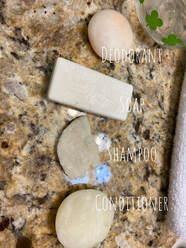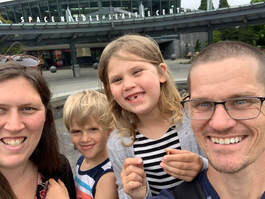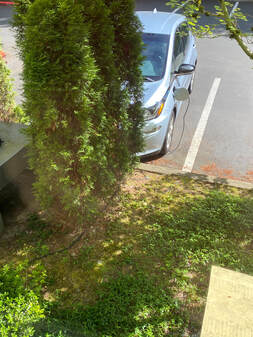
Road trips are very big in our family. Shelter in Place hit us particularly hard as it happened just as we were leaving for a two week tour of the Northwest that would include Portland, Seattle, Vancouver, Boise, Salt Lake City and Reno. We had to cancel that trip and just dream about it and other adventures we would normally undertake in the Spring as we built box forts, filled our pool, went on long bike rides around our city and struggled through distance learning with our children.
Last week we finally felt comfortable enough to attempt at least part of our trip and that has inspired this post, how to travel in a eco-friendly way.
Our two biggest focuses are waste minimization and emission-free transportation, but we do also still practice water and energy conservation.
Minimal waste travel:
- Preparing snacks: When it's not a last minute trip, you usually have the 2-3 days before to make up some yummy Zero Waste road trip snacks. Home made cheese crackers, trail mix, granola bars, on-the-go pies, are all good car munchies. sometimes I'll make a loaf of zucchini or pumpkin bread, pre slice it and put it in glass tupperware or Stasher bags. We also make a easy to transport meal (this time was Mac 'n' Cheese and a jar salad for the first day so we don't have to rely on fast food. This made it easier during this time to limit having to go in stores and restaurants other than for potty breaks. A key when packing your food for travel is to use containers that can be condensed, stacked inside one another or cleaned and reused to hold other items. This way as the food disappears, those containers are taking up less room. We used a glass storage container for the mac 'n' cheese, were able to stack other containers inside, but found out our current hotel is not offering breakfast, so we were able to use that glass container as a bowl to make quick-oats that we had brought along. saves waste, time and money.
- Waste in the hotel: We specifically stay at Marriott hotels as we have been reward members a long time and I have a lot of knowledge of how to get the most out of their rewards program (please reach out if you want to sign up as a rewards member or for their rewards credit cards, I can give you a referral with bonus points and give you some tips). But Marriott has also been stepping up in the green space, they mandated all hotels much switch to refillable soap and shampoo dispensers instead of providing the little plastic bottles. Also many hotels encourage you to reuse towels and will even provide extra rewards points for skipping housekeeping service during your stay. We often try to pick brands like the Towneplace Suites and the Residence Inn when possible because they have full kitchens where we can cook our own food and reduce takeout and the associated waste or where we can bring the plates, bowls and cups down from our room for the provided breakfast if they are serving it on disposables. This is particularly useful for the complimentary coffee, way better to put it in a mug from your room or directly into your own reusable travel cup.
- When you need to eat out: Obviously we don't pack two weeks worth of food to bring with us, its not worth taking up that much space in the car. We also do enjoy buying local food and supporting local restaurants. We try to practice the same hacks we use at home. When possible, get the meal "for here" and slip any leftovers into your own empty containers. Ask up front, like when you are ordering, for no plastic straws or utensils, repeat as needed. If you still get a piece of plastic after explicitly asking not to receive one, put it in a Yelp review (in a gently suggestive way, not in an irate way), and they will most likely be more conscious going forward, many restaurants do read their reviews.
Driving Electric:
We own a fully electric Chevy Bolt (we actually own a Mitsubishi iMiEV too, but that's not a road trip car) and have not owned a gasoline car for over 3 years. The Bolt goes approximately 240 miles on a charge and there are now many Level 2 (approx 25 miles of range per hour) and Level 3 or DC Fast (between 100-250 miles range per hour) stations all along every highway in the US. We can usually drive 2 1/2- 4 hours between stops, which is as long as our kids' little bladders are going to hold out anyway. We shoot for 50+kW stations for quick pit stops as we'll only need to charge 45-60 minutes, enough time for a potty break and quick bite. When we are going to be exploring, we can find a Level 2 station, sometimes we can even score free parking or a preimo parking spot but utilizing a charging spot. Charging costs vary very widely, its best to use apps like Plugshare and ChargPoint to see where stations are, if they are function, what the cost is and if there are any restrictions for use. Lots of stations are free or only charging a reasonable per kWh charge (in states that allow per kWh pricing), but others will tack on session fees, per minute or per hour fees or additional charges. We try to scope out hotels that have or are very near charging stations so we have flexibility to always get a full charge overnight, but we have also had a lot of luck asking to plug in at a standard 110V outlet somewhere on the property and can get from 1/4-1/2 charge overnight for free. I won't say that there are no logistical challenges to driving electric, there is certainly a period of trial and error when you are new to owning a electric car. But now, to us anyway, the logistics of charging and scoring that free charge or great parking spot are part of the adventure.
Last week we finally felt comfortable enough to attempt at least part of our trip and that has inspired this post, how to travel in a eco-friendly way.
Our two biggest focuses are waste minimization and emission-free transportation, but we do also still practice water and energy conservation.
Minimal waste travel:
- Preparing snacks: When it's not a last minute trip, you usually have the 2-3 days before to make up some yummy Zero Waste road trip snacks. Home made cheese crackers, trail mix, granola bars, on-the-go pies, are all good car munchies. sometimes I'll make a loaf of zucchini or pumpkin bread, pre slice it and put it in glass tupperware or Stasher bags. We also make a easy to transport meal (this time was Mac 'n' Cheese and a jar salad for the first day so we don't have to rely on fast food. This made it easier during this time to limit having to go in stores and restaurants other than for potty breaks. A key when packing your food for travel is to use containers that can be condensed, stacked inside one another or cleaned and reused to hold other items. This way as the food disappears, those containers are taking up less room. We used a glass storage container for the mac 'n' cheese, were able to stack other containers inside, but found out our current hotel is not offering breakfast, so we were able to use that glass container as a bowl to make quick-oats that we had brought along. saves waste, time and money.
- Waste in the hotel: We specifically stay at Marriott hotels as we have been reward members a long time and I have a lot of knowledge of how to get the most out of their rewards program (please reach out if you want to sign up as a rewards member or for their rewards credit cards, I can give you a referral with bonus points and give you some tips). But Marriott has also been stepping up in the green space, they mandated all hotels much switch to refillable soap and shampoo dispensers instead of providing the little plastic bottles. Also many hotels encourage you to reuse towels and will even provide extra rewards points for skipping housekeeping service during your stay. We often try to pick brands like the Towneplace Suites and the Residence Inn when possible because they have full kitchens where we can cook our own food and reduce takeout and the associated waste or where we can bring the plates, bowls and cups down from our room for the provided breakfast if they are serving it on disposables. This is particularly useful for the complimentary coffee, way better to put it in a mug from your room or directly into your own reusable travel cup.
- When you need to eat out: Obviously we don't pack two weeks worth of food to bring with us, its not worth taking up that much space in the car. We also do enjoy buying local food and supporting local restaurants. We try to practice the same hacks we use at home. When possible, get the meal "for here" and slip any leftovers into your own empty containers. Ask up front, like when you are ordering, for no plastic straws or utensils, repeat as needed. If you still get a piece of plastic after explicitly asking not to receive one, put it in a Yelp review (in a gently suggestive way, not in an irate way), and they will most likely be more conscious going forward, many restaurants do read their reviews.
Driving Electric:
We own a fully electric Chevy Bolt (we actually own a Mitsubishi iMiEV too, but that's not a road trip car) and have not owned a gasoline car for over 3 years. The Bolt goes approximately 240 miles on a charge and there are now many Level 2 (approx 25 miles of range per hour) and Level 3 or DC Fast (between 100-250 miles range per hour) stations all along every highway in the US. We can usually drive 2 1/2- 4 hours between stops, which is as long as our kids' little bladders are going to hold out anyway. We shoot for 50+kW stations for quick pit stops as we'll only need to charge 45-60 minutes, enough time for a potty break and quick bite. When we are going to be exploring, we can find a Level 2 station, sometimes we can even score free parking or a preimo parking spot but utilizing a charging spot. Charging costs vary very widely, its best to use apps like Plugshare and ChargPoint to see where stations are, if they are function, what the cost is and if there are any restrictions for use. Lots of stations are free or only charging a reasonable per kWh charge (in states that allow per kWh pricing), but others will tack on session fees, per minute or per hour fees or additional charges. We try to scope out hotels that have or are very near charging stations so we have flexibility to always get a full charge overnight, but we have also had a lot of luck asking to plug in at a standard 110V outlet somewhere on the property and can get from 1/4-1/2 charge overnight for free. I won't say that there are no logistical challenges to driving electric, there is certainly a period of trial and error when you are new to owning a electric car. But now, to us anyway, the logistics of charging and scoring that free charge or great parking spot are part of the adventure.



 RSS Feed
RSS Feed